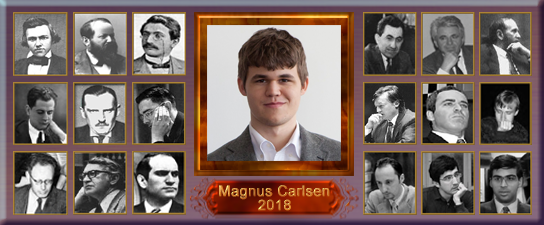|

“Computers
are barred from competing for all titles”
This section looks briefly at the careers and sporting styles of the greatest Chess players of all time, the world champions. One of the best ways to improve your strength at the
chessboard is by studying the games of the most distinguished proponents of the art of Chess from the past. Each champion has their own particular brand of play - be it aggressive, attacking, tactical or strategic - which is just as personal as their signature.
Try to identify which champions appeal most to you and then study them in depth. This will provide you with a systematic method of playing. The adopt a legend technique has worked well for many Chess experts. This is probably the best way to improve your playing style once you have got over the hurdle of the elementary stage. Choose a hero/heroine and examine his/her games in depth. An attacking player could choose from Tal, Alekhine or Kasparov. The strategic player could emulate Petrosian, Botvinnik or Capablanca.

The first officially recognized world Chess championship was held in 1886, when Wilhelm Steinitz beat Johannes Zukertort in a match held in the USA. The outstanding players before this date are known, but there were no official champions. Ruy Lopez achieved his reputation by beating the best Italian players and by writing the Libro del Axedrez, a collection of Chess openings and general advice and analysis.
The leading Italian players at this time were Paolo Boi and Leonardo da Cutri. Boi was renowned for his ability to play three games at once without sight of the board, a skill that astonished his contemporaries. A generation later, Gioaccchino Greco was the best known Italian master. He traveled throughout Europe playing matches for high stakes and compiled manuscripts on Chess openings, two of which survive in the Bodleian Library in Oxford and the British Library in London.
In 1620 he wrote his analysis of some composed games and illustrated two different ways to play Chess - the player who tries to capture as many of the opponents pieces as possible and the player who sacrifices pieces. He considered tactics very important.
The 18th century player, Philidor, was a master of blindfold Chess. Francois Andre Danican Philidor, musician and composer, dominated French and English Chess circles for nearly half a century.
He was the first player to try to systematize Chess knowledge and his Analyse du Jeu des Echecs (Chess Analyzed), is a very influential book of the period which appeared in 100+ editions.
Philidor was the first great player to understand the importance of Pawns, which he described as the soul of Chess and drew attention to their strengths and weakness in his book. Philidor's middle game advice was his most important contribution to posterity.
He saw planning as an extremely important part of the game (once your pieces are developed you should plan an overall goal - kingside or queenside attack etc).
He believed that a mobile mass of Pawns were an important factor during the middle game. Allowing Pawns to be isolated, doubled or backward was another important insight and he was also the first to discuss how a Bishop could be good or bad depending on the Pawn structure.
He also discussed the positional sacrifice by which a player obtains an advantage i.e., major piece mobility or minor piece structure. Another Frenchman, Alexandre Deschapelles was an extremely talented player and his pupil Louis La Bourdonnais was recognized as unofficial world champion. In 1834 he defeated the leading Irish player Alexander McDonnell over 85 games.
By 1843 Howard Staunton became Europe's leading player.
In 1841 he founded the first successful Chess magazine the Chess Players Chronicle. His two great contributions to Chess literature were the books Chess Praxis and The Chess Players Handbook. Wilhelm Steinitz became world champion when he defeated Johann Zukertort in 1886. His influence on modern Chess was immense.
Steinitz understood the importance of building up positional advantages in order to win, and his ideas were published in his book Modern Chess Theory.
He remained world champion until 1894 when he was 58 years of age. He coined the term 'hole' (a vulnerable cell that has lost its Pawn protection and may be occupied by an opposing major piece) and is seen as the first player to take an academic/scientific approach to Chess playing.
Emanuel Lasker won the title in 1894 and held it for a record 27 years. In 1921 Jose Capablanca won the title. Max Euwe had a brief two years as champion. Smyslov became champion in 1957/58.
The greatest attacking genius of modern Chess, Mikhail Tal was champion from 1960 to 1961.
The world champion between 1963-1969 was Tigran Petrosian. 1969 saw Boris Spassky take the title. Bobby Fischer became champion in 1972. Anatoly Karpov became champion in 1975. Gary Kasparov became world champion in 1985.
|